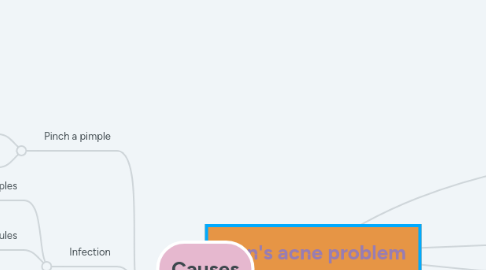
1. Infection from bacteria.
1.1. After the pore is block, bacteria infect and cause inflammation.
2. Over cleaning
2.1. Dryness is another major concern that arises due to excessive washing as you strip your face of its natural oils.
2.2. By cleansing your face too much, you’re harming the skin barrier that can make the skin more prone to rashes and other skin problems such as acne.
3. Causes
3.1. Pinch a pimple
3.1.1. Risk of breaking skin barrier and then causes permanent scar and infection.
3.1.2. Can spread bacteria to another spot and create more or big acne.
3.2. Infection
3.2.1. Infected pimples
3.2.1.1. Bacterial infection by bacteria called “Propionibacterium acnes” that lives on skin.
3.2.2. Papules
3.2.2.1. Excess oil and skin cells that clogged pore to feed bacteria.
3.2.2.2. Stress.
3.2.3. Pustules
3.2.3.1. Most papule became pustules after a few day.
3.2.3.2. Pop papule.
3.2.3.2.1. Popping pimples.
3.3. Inflammation
3.3.1. Physicals reaction(pinches pimples).
3.4. Poor diet
3.4.1. Consume less of lipid consequent lack of vitamin soluble in lipid.
3.5. Cell produce lipid
3.5.1. Acne begins with fat clogging pores which may be initiated by dirt or excessive lipid.
4. When acne is resistant to topical therapies, oral antibiotics may be used. Oral antibiotics commonly are initial therapy in patients with moderate to severe inflammatory acne.
5. The technical term is retention hyperkeratosis, but all it really means is the skin cells are hanging around longer than they should, getting trapped in the pore.
6. Doxycycline (e.g., Vibramycin, Doryx)
7. Solutions
7.1. Clinic
7.1.1. Comedolytic
7.1.1.1. For those of us prone to acne, comedolytic products are exactly what the skin needs.
7.1.1.2. Acne is, in part, caused by an abnormal shedding of skin cells.
7.1.2. Oral antibiotics
